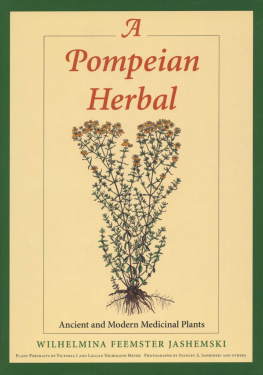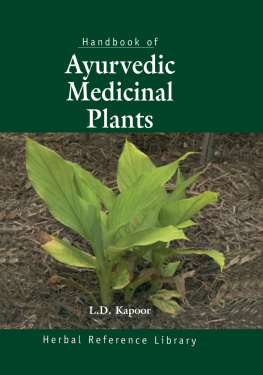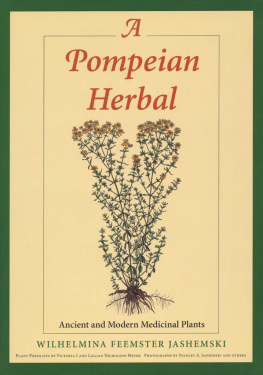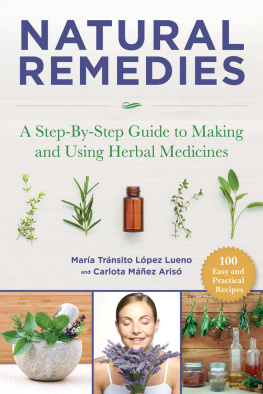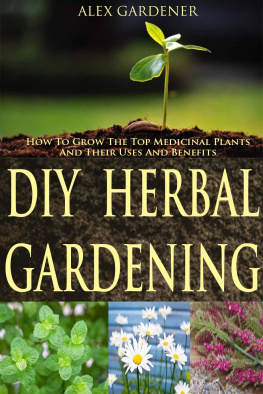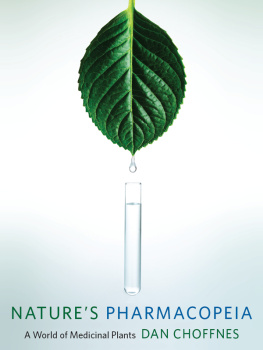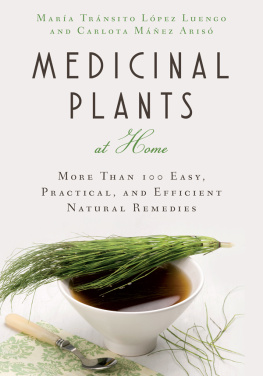PLANT PORTRAITS BY VICTORIA I AND LILLIAN NICHOLSON MEYER
PHOTOGRAPHS BY STANLEY A. JASHEMSKI AND OTHERS
A Pompeian Herbal
Ancient and Modern Medicinal Plants
Wilhelmina Feemster Jashemski

UNIVERSITY OF TEXAS PRESS,
AUSTIN
Copyright 1999 by the University of Texas Press
All rights reserved
First edition, 1999
Requests for permission to reproduce material from this work should be sent to Permissions, University of Texas Press, Box 7819, Austin, TX 787137819.
LIBRARY OF CONGRESS CATALOGING-IN-PUBLICATION DATA
Jashemski, Wilhelmina Mary Feemster, 1910A Pompeian herbal : ancient and modern medicinal plants / Wilhelmina Feemster Jashemski ; plant portraits by Victoria I and Lillian Nicholson Meyer ; photographs by Stanley A. Jashemski and others. 1st ed.
p. cm.
Includes bibliographical references (p. ) and index.
ISBN 0-292-74061-1 (acid-free paper)
ISBN 0-292-74060-3 (pbk. : acid-free paper)
1. Materia medica, VegetableItalyPompei. 2. Medicinal plantsItalyPompei. 3. Medicine, Greek and Roman. I. Title.
RS177.18 J37 1999
615'.321'09377dc219851226
Publication of this book has been generously assisted by grants from the National Endowment for the Humanities and the Gladys Krieble Delmas Foundation.
ISBN 978-1-4773-0267-5 (library e-book)
ISBN 978-1-4773-0268-2 (individual e-book)
doi: 10.7560/740617
This book is not intended as a guide to self-medication by consumers. The reader is advised to discuss the information contained herein with a doctor, pharmacist, nurse, or other authorized health care practitioner. Neither the author nor the University of Texas Press accepts responsibility for the accuracy of the information itself or the consequences from the use or misuse of the information in this book.
Abbreviations of Authors Cited or Quoted
Apicius | Apicius, The Roman Cookery Book |
Celsus | Celsus, De medicina |
CMG | Corpus Medicorum Graecorum |
Columella | Columella, De re rustica |
Dioscorides | Dioscorides, De materia medica |
Galen, De simpl. med. temp. ac fac. | Galen, De simplicium medicamentorum temperamentis ac facultatibus |
, in Hippoc. | , Commentarii I in Hippocratis librum de humoribus |
Guarrera | Guarrera, Il Patrimonio Etnobotonico del Lazio |
Martial | Martial, Epigrams |
Ovid, Met. | Ovid, Metamorphoses |
Pliny, HN | Pliny, Historia naturalis |
Riddle, Contraception and Abortion | Riddle, Contraception and Abortion from the Ancient World to the Renaissance |
, Dioscorides | Riddle, Dioscorides on Pharmacy and Medicine |
Scribonius Largus | Scribonius Largus, Compositiones |
Soranus | Soranus, Gynecology |
Theophrastus | Theophrastus, Enquiry into Plants |
Tolkowsky | Tolkowsky, Hesperides: A History of the Culture and Use of Citrus Fruits |

Medicinal plants growing at Pompeii in the shadow of Vesuvius
Preface
It is always a pleasure to express gratitude to those who have contributed to my work. Many people through the years have had an important part in the development of this book. It was first of all my workmen at Pompeii who introduced me to the herbs that they gathered to use as medicine. Then other workmen in the excavations, their friends and families, and also townspeople showed me the medicinal plants that they gathered, and explained their use. Dr. Pietro Soprano, Director of the Excavations at Pompeii, and later at Stabiae, gave me valuable information about medicinal plants in use at Pompeii and introduced me to neighbors living within the excavations who collected medicinal plants. It was he who directed a workman to get for me specimens of the miraculous potato (Cyclamen hederifolium) at Stabiae. The specimens that we collected of the plants being used for medicine are deposited in the U.S. National Arboretum herbarium in Washington, D.C.
In a book concerned with medicinal plants, the aid of botanists who know the flora of the area is indispensable. I have been fortunate in having the help and advice of four eminent botanists. For many years Dr. Frederick G. Meyer, Research Botanist in charge of the herbarium at the U.S. National Arboretum in Washington, D.C, now retired, has cooperated in my work on the gardens of Pompeii and the surrounding area. He has accompanied me on four trips to the Vesuvian sites and botanized the area, collecting specimens for the Arboretum herbarium, and he has documented many of the medicinal plants. His wife, Lillian Nicholson Meyer, a botanical artist, generously offered to make drawings of the specimens of the medicinal plants that I had collected.
Early in my research, I was privileged to meet the botanist Dr. Paolo M. Guarrera, now professor at the University La Sapienza, in Rome, who was making a detailed study of medicinal plants used in Latium, the larger territory in which Rome is situated. From him I learned much. Professor Massimo Ricciardi of the Department of Arboriculture, Botany and Plant Pathology, University of Naples Federico II at Portici, who has closely collaborated with me in my work on Vesuvian gardens, has contributed greatly to this book. His interest in and knowledge of the medicinal plants used in the Pompeii area is considerable, and he generously gave me detailed information about plants he has used in treating his own family, in addition to other plants in the area used for medicine. He introduced me to Professor Matteo Giannatasio, a botanist at the University of Naples Federico II, in Naples, who is also interested in medicinal plants. All four of these botanists have read my manuscript, and their corrections and suggestions have greatly improved it. Dr. Francis M. Hueber, chief paleobotanist at the Smithsonian Institution, Washington, D.C., has also aided my work, accompanying me on two trips to the Vesuvian sites. Four of his beautiful scanning electron microscope photographs appear in this book.
The untimely death of Lillian Nicholson Meyer, before she had been able to complete her handsome plant portraits for this book, made its publication very doubtful. I am much indebted to the gifted artist Victoria I, who generously offered to make the many additional drawings needed, thus making this book possible.
I have been fortunate in receiving many grants for my work, which I also acknowledge with gratitude, beginning with a grant from the American Philosophical Society. A Biomedical Services Support Grant aided my research on the medicinal plants used at Pompeii. Funds for my excavations in the Vesuvian sites were granted by the General Research Board of the University of Maryland, and in large part by the National Endowment for the Humanities, beginning with the award of a Senior Fellowship in 19681969 and generous research grants from 1972 to 1978. Dumbarton Oaks, Washington, D.C., also supported my excavations. The authorities at Pompeii and other Vesuvian sites generously furnished heavy equipment and additional workmen for my excavations.
Next page
